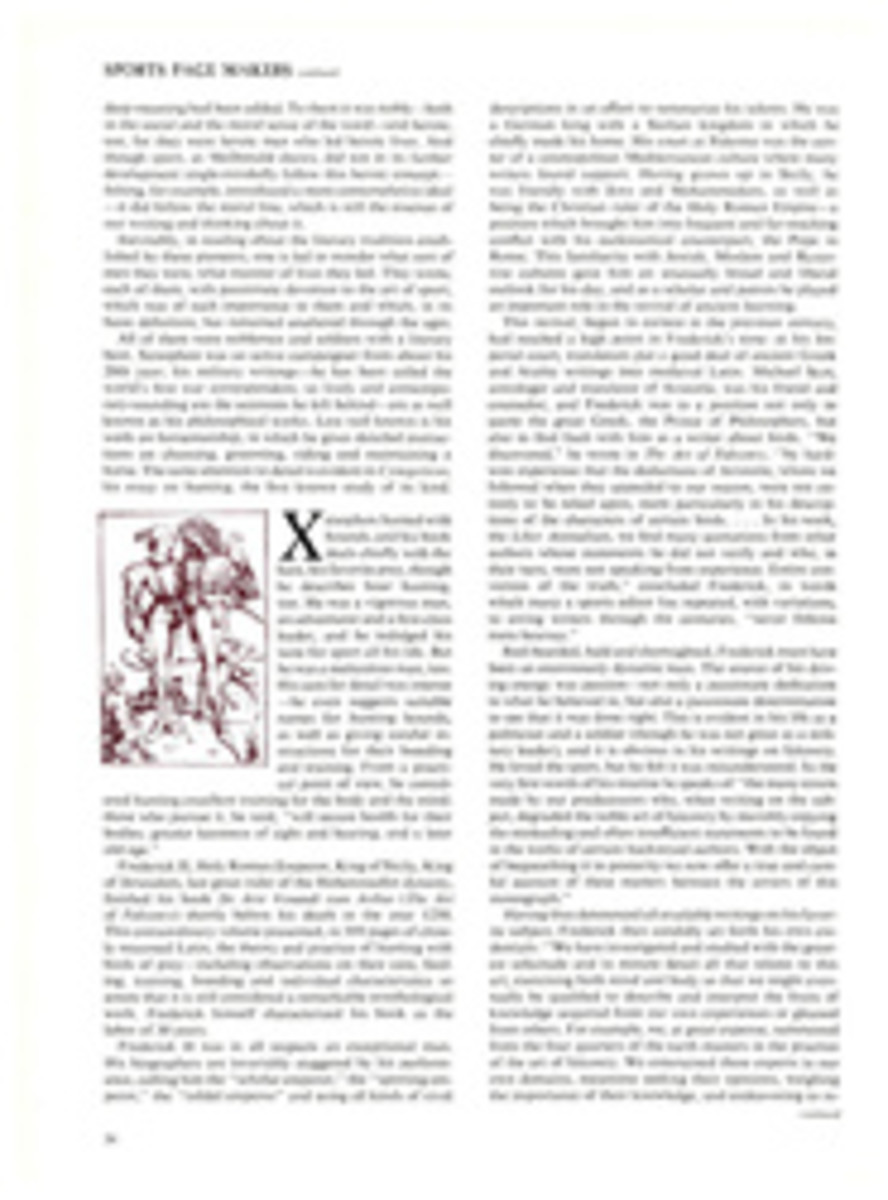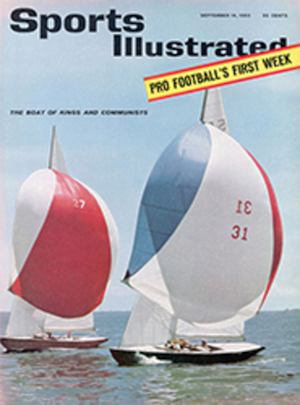
Two Texans shoot it out with a pair of 5.5s
It was a day for heavy-weather sailors. Chill early-autumn winds were gusting down Long Island Sound at speeds up to 30 knots, and the fleet of 5.5-meter yachts competing in the third race for the U.S. National Championship swept toward the finish line like maple leaves ahead of a gale. Under such turbulent, testing conditions, few of the observers present were surprised to find that the first two boats across the line, by a comfortable margin, were occupied by an unlikely pair of oil-rich Texas brothers, 50-year-old Albert Fay, in his red-hulled Flame, and 49-year-old Ernest Fay, in Yale-blue Pride (see cover).
The Fays are on the Sound, along with a Norwegian Crown Prince, a Soviet naval officer, a Leningrad mill hand and assorted Swedish, German and Swiss sailors, to take part in a month-long regatta at Long Island's aristocratic Seawanhaka Corinthian Yacht Club. The ultimate purpose of it all is to determine the best 5.5-meter sailor in the world. When the month is up, that distinction may well belong to one of the Fays. There are about 400 5.5s in the world (117 in Soviet Russia alone), and only three of these come from the state of Texas. But two of the three belong to the Fays—and how many boats do two men need to gain a monopoly anyway?
Between them at one time or another Albert and Ernest Fay have collected many of the world's available 5.5 prizes as well as a cabinetful of trophies in other classes. They first learned to sail as boys at Bay St. Louis in Mississippi—first in catboats, then in two old, leaky 30-footers that, according to Ernie, "anyone could get a sail in if he was willing to crouch in the bilges and bail." Later Ernie went to Harvard and Albert to Yale to study geology. Now, old Eli Albert sails a boat colored for Harvard, and Cantab Ernie one painted blue for Yale.
When they are not sailing 5.5s, the Fays keep in tune aboard Corinthian One-Designs, 19-foot sloops that look like Lightnings fitted with keels instead of centerboards. Albert, the family extravert, who races with a red cap on backward for luck, is the current Texas Corinthian champion. He is also a staunch Barry Goldwater supporter and a Republican National Committeeman. "I didn't try out for the Olympics," says politically minded Albert in the firm, conservative tones of a man who believes in first things first, "because they came in a presidential election year."
Ernie, on the other hand, lives for boats, and not only sails them but designs them as well. Well below average height and generally soft-spoken, Ernie Fay was one of the first U.S. sailors to become enthusiastic about the 5.5-meter class. Like other would-be Olympic sailors he demoted himself into the 5.5s from the bigger, far more expensive 6-meter boats that were once the mainstay of Olympic competition. (It is an irony that 5.5s now cost just as much as Sixes used to.) The Bill Luders-designed Sabre shown on the following page was Ernie Fay's first 5.5. Then he decided to design one for himself. Pride was the result.
"Designing a boat means as much as sailing it," says Sailor-Designer Ernie Fay. "A good designer ought to get out and race his own boats. Otherwise he loses touch with what is practical and just gets lost in theory."
As a naval architect, Ernie, though technically an amateur, does not restrict himself to sail. He has designed a speedboat capable of zipping from zero to 30 mph in five seconds—even though success evaded him on the first attempt. The first boat was drawn from calculations printed in a journal of naval architecture. "She was a failure," says Ernie, "and we soon found out why. In the next issue of the journal they printed a story saying that they were sorry but the calculations were incorrect."
Apart from considerable interests in Texas gas and oil, the Fay brothers jointly own a shipyard near Houston. It is a neat installation at Seabrook on milky Clear Creek where shrimpers from the Gulf of Mexico spend Saturday nights with no Sunday mornings. Here, in the yard where both Flame and Pride were built, Ernie tests his ideas.
Unlike such one-design class boats as the Stars and Lightnings, which are all identical—in theory, at least—meter boats are built with individual variations in design restricted only by a general formula (the quotient of the formula equation must not exceed 5.5; hence the name). In the hotly competitive business of making one 5.5 sail faster than another, rival designers are constantly eying one another's products to detect that elusive quarter inch here or half ounce there that makes all the difference at the finish line of a race. Like all 5.5 designers, Ernie Fay is fiercely jealous of his secret's. "Rush VII" he says with unaccustomed heat of a boat designed by Sweden's Naval Architect Einar Ohlson, "has a strange resemblance to my Pride. The only way you can tell them apart is by their color. Her sheer [the curved line of a boat's deck] is a little straighter, and her rudder is an inch or two different, but otherwise they are the same boat."
"We took a template of Pride's midship section and laid it against the Swedish boat," says Albert in confirmation, "and they didn't vary a quarter inch."
"What satisfaction," asks Ernie of the world in general, "can a designer get from copying someone else's boat?"
At some $30,000 apiece, boats of the 5.5-meter class are far more expensive to design, to build and to race than any one-design of comparable size. And there are many sailors who believe they are not worth the trouble or the money. These dissenters say the 5.5s are too demanding and too dangerous to race. They claim that spinnakers up to 800 feet square are too big for the boats, and they point to the number of 5.5s that have taken spectacular knockdowns while racing before strong winds. Ernie Fay disagrees. "For the Olympics you need a demanding sort of boat," he insists. "The Olympics are meant to be a test of athletic prowess, and Olympic sailing shouldn't be any exception. In 5.5s," adds the sinewy sailor, "you expect that sort of test. Furthermore, the crews like the boats because of the challenge they offer. If they didn't, they'd be sailing in Dragons or," he laughs, "that old man's boat, the IOD [the similar-sized International One-Design]."
What Ernie Fay neglects to add is that it helps to have the agility of a Nijinsky, the bravura of an Errol Flynn and the endurance of Gibraltar when crewing on a 5.5. When not trimming the jib or working the running backstays, the two crewmen demanded by a 5.5 huddle in the bottom of a chest-high cockpit or pump out the gallons of spray that slosh dismally over the foredeck going upwind. Running before the wind or reaching across it with an overfed spinnaker, the crew keeps just as busy trimming the sheet and guys and wondering whether the next puff will suck the boat completely out of control or knock it flat. "You've got to be rugged," says Ernie Fay, "to sail a 5.5."
Rugged Ernie and his rugged brother Albert will have some rugged competition to contend with during the next month. Norway's young Crown Prince Harald is a top 5.5 sailor who needs none of the special advantages given to his sailing father, King Olav. "A Norwegian told me," says Ernie Fay, "that in Norway it always pays to follow the King across the starting line because, early or not, the race committee never dares to call him back." The sailing skippers from Russia, Naval Captain Konstantin Alexandrov and Mill Hand Viktor Gorlov, offer competition from behind the Iron Curtain that should give the Goldwater backers from Texas plenty of trouble. An even more potent threat comes from Sweden's Gold Cup winner Lars Thorn who managed to slip in ahead of the Fays for the U.S. title. Then there is the current Olympic champion, Philadelphia's Dr. Britton Chance. Whether or not any of these should beat them, however, the fiercest competition Albert and Ernest Fay will face on Long Island Sound will be that provided by Ernest and Albert Fay. Off the water they blend like Texas and Cadillacs, but on the water they have a tendency to forget that they are related. "In one overseas regatta," says Albert's daughter Marion, "we were way out ahead of Uncle Ernie. We must have had nine boats between us, but all Daddy could do was fuss about Uncle Ernie. 'What's he doing?' he'd say. 'Why's he tacking now? Where's he going? Why's he doing that?' When Pride got hidden by some other boats, Daddy couldn't keep still. 'Where's he gone now? Why can't I see him?' You'd have thought there weren't any other boats in the race. When Daddy's racing he thinks Ernie's got him snake-bit."
It may be that before the racing is over on the Sound this month a lot of other 5.5 sailors will have the same sentiments about both brothers.
PHOTO
PHOTO
NORWAY'S CROWN PRINCE HARALD RELAXES AT THE TILLER IN RARE MOMENT OF CALM
PHOTO
NAVY OFFICER KONSTANTIN ALEXANDROV (LEFT) HEADS FOR RUSSIAN VICTORY
ILLUSTRATION
ALLEN BEECHEL
5.5
A VERY EXPENSIVE BOAT
As nearly typical as any member of the 5.5-meter class can be, Ernie Fay's former boat Sabre, designed by A. F. (Bill) Luders, measures 33 feet overall, 23 feet on the water, has a beam of 6 feet 6 inches and draws 4 feet 6 inches. Her mainsail and working jib (5.5s don't use genoas) spread a total area of 312 square feet and the largest of her spinnakers is close to 800 square feet. All these factors, along with her weight (which, like that of all 5.5s, remains a secret closely guarded by owners, designers and official measurers) and several other measurements, have been carefully balanced by her designer to produce a quotient of 5.5 meters under the formula governing the class design. Although different from the international rule controlling the America's Cup Twelves, the 5.5 formula still permits wide individual variation of design, making the designer an important man in 5.5 competition. Current top designer is Bill Luders, followed in the U.S. by C. Raymond Hunt, designer of the present Olympic champion Minotaur, and amateur Ernie Fay. Sweden's Einar Ohlson, Norway's Bjarne Aas and a number of talented Russians are the best designers overseas.
Because of the infinite care put into their building, 5.5s are by far the most highly priced racing yachts of their size. Hulls cost about $25,000, the designer's fee ranges between $1,500 and $2,000, tank testing of models can cost from $1,200 to $1,500, and a further $2,500 is necessary for sails. Because of lower labor costs, however, a good 5.5 hull built overseas, especially in Scandinavia, can be delivered in the U.S. for only $10,000.

